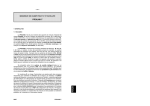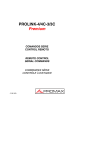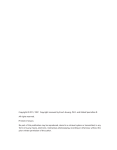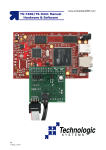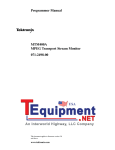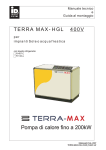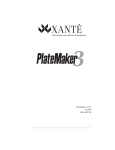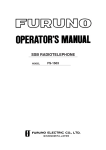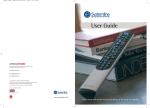Download tvexplorerii_ii+
Transcript
TV EXPLORER II / II +
REMOTE CONTROL
USB COMMANDS
SAFETY NOTES
Read the user’s manual before using the equipment, mainly " SAFETY RULES "
paragraph.
The symbol
on the equipment means "SEE USER’S MANUAL". In this
manual may also appear as a Caution or Warning symbol.
Warning and Caution statements may appear in this manual to avoid injury
hazard or damage to this product or other property.
USER’S MANUAL. REMOTE CONTROL COMMANDS TV EXPLORER II / II +
T A B L E
C O N T E N T S
REMOTE CONTROL WITH A PC ............................................................................. 1
1.1 Introduction.......................................................................................................... 1
1.2 Protocol for communication between the TV EXPLORER II I II+ and a PC....... 1
1.3 Power on using USB port .................................................................................... 3
1.4 Remote orders..................................................................................................... 3
English
1
O F
USER’S MANUAL. REMOTE CONTROL COMMANDS TV EXPLORER II / II +
USER’S MANUAL. REMOTE CONTROL COMMANDS TV EXPLORER II / II +
REMOTE CONTROL
USB COMMANDS
TV EXPLORER II / II +
1 REMOTE CONTROL WITH A PC
1.1 Introduction
1.2 Protocol for communication between the TV EXPLORER II / II + and a
PC
This protocol is controlled by software and is using a virtual serial port over an
USB interface. Data and information are exchanged using messages consisting of
ASCII alphanumerical characters. This method ensures easy carrying between different
types of personal computers.
To activate the virtual serial port, a special driver must be installed. The driver is
included with the purchased instrument.
Connections
The cable between the TV EXPLORER II / II + and the PC must be a standard
A to B type USB cable PROMAX reference CC-040 or equivalent.
Figure 1.- USB A-B standard connection cable.
09/2007
Page 1
English
The design of TV EXPLORER II / II +, based on a microprocessor, allows data
to be exchanged between the equipment and a remote controller (personal computer)
via an USB connector. It is thus possible to obtain data as well as remote control of the
TV EXPLORER II / II + (measurement mode, video format, DATALOGGER status, etc.)
for maintenance purposes and monitoring of installations.
USER’S MANUAL. REMOTE CONTROL COMMANDS TV EXPLORER II / II +
The TV EXPLORER II / II + accepts remote commands at any time, which the
instrument is on, except when in print mode. That is, it is not necessary to put the
instrument in special remote control mode; rather, this mode is selected immediately when
it detects a complete command during the time necessary for its execution.
The communication protocol is as follows:
1.-
TV EXPLORER II / II + transmits a XON code (11H) every second. The
aim is to indicate to any possible remote device that the equipment is
ready to receive data.
2.-
At this moment, data streams can be sent it. Each data stream is
composed by:
a.
Stream beginning: ‘∗’ (code 2AH)
b.
Set of characters that describe data message.
c.
CR (carriage return, code 0DH)
3.-
Once a data stream has been sent, will be received a XOFF (code 13H)
indicating that the transmission is stopped
4.-
Next, in case of correct message an ACK (acknowledge, code 06H) is
expected or a NAK (not acknowledge, code 15H) in the opposite case.
5.-
If the sent message requires answers it will be sent at this moment.
6.-
Once completed the data stream transmission, the TV EXPLORER II / II +
will send a XON (code 11H) indicating that already it is prepared to receive
a new data stream.
A typical communication chronogram would be as follows:
PC (REMOTE CONTROLLER)
1)
2)
3)
4)
5)
6)
7)
*?TV<CR>
TV EXPLORER II / II +
<----------->
<-----<-----<------
XON
XOFF
ACK
*TV0<CR>
<------
XON
wait ...
(all characters are transmitted in ASCII code)
In print mode, as the same port is used as for the data dump to the printer, all
data received is rejected and no XON character is transmitted until leaving this mode.
Commands should always be sent in capital letter and cannot be edited online,
i.e., once a character is received it is stored in the TV EXPLORER II / II + buffer and
cannot be rectified by sending an erase code.
Page 2
09/2007
USER’S MANUAL. REMOTE CONTROL COMMANDS TV EXPLORER II / II +
Commands in remote control are divided in to two groups, orders and
interrogations. Orders modify a variable or the equipment status. Interrogations respond
with information concerning equipment status or the value of a variable. For
interrogative command, it is necessary to add the character ´?´ after the character '∗'.
1.3 Power on using USB port
The equipment can start up being stopped, by means of the USB port.
Following the steps:
1.- Send 5 asterisks. ‘∗∗∗∗∗’
2.- Wait for 1 second.
3.- Send ‘∗∗’
1.4
Remote commands
NOTE 1:
The (') character should not be sent; it is only included in the description in
order to define the string that makes up the remote command.
NOTE 2:
The values given in small letter are parameters that change in value
depending on the function to be executed. These values are always decimal
or hexadecimal ASCII characters. For example, to transmit the value '1', we
must send the hexadecimal code 31 that corresponds to this character.
Consult the text for acceptable value margins. The transmission of erroneous
parameters or contradictory information may cause TV EXPLORER II / II +
to stop operating correctly. In this case, it is necessary to reset the
equipment by shortly switching it off.
IMPORTANT REMARK:
In the case of transmitting to the TV EXPLORER II a command
corresponding to some nonavailable function, this one will generate a run
time error.
09/2007
Page 3
English
Next, will be described the set of commands that the TV EXPLORER II / II +
accepts. All commands are transmitted in ASCII code.
USER’S MANUAL. REMOTE CONTROL COMMANDS TV EXPLORER II / II +
•
Command: '*'
NULL Command. Tests communication.
Syntax:
•
Interrogation:
'*<CR>'
Response:
'ACK'
Command: 'AI'
Interrogates if the program is auto-identifying some
signal or not.
Syntax:
Interrogation:
'*?AI<CR>'
Response:
'*AIx<CR>'
Where:
x=
0:
1:
•
Command: 'AP'
Not carrying out auto-identification.
Auto-identification in progress.
Activates / deactivates the Auto Power Off function. Also,
it allows to set the timer for this function.
Syntax:
Selection:
'*APsxxxx<CR>'
Where:
s=
'A':
'M':
'T':
xxxx =
Turns on the Auto Power Off function.
Turns off the Auto Power Off function.
Allows to modify the Auto Power Off timer when this
function is activated.
Time in minutes to Power Off.
Example:
'*APA<CR>'
'*APM<CR>'
'*APT0010<CR>'
Page 4
Turns on the Auto Power Off function.
Turns off the Auto Power Off function.
Sets to 10 minutes the auto power off timer.
09/2007
USER’S MANUAL. REMOTE CONTROL COMMANDS TV EXPLORER II / II +
•
Command: 'AT'
Selects / interrogates the attenuators
Syntax:
Attenuator selection:
'*ATa<CR>'
Interrogation:
'*?AT<CR>'
Response:
'*ABba<CR>'
Where:
b=
A:
M:
Auto
Manual
00:
10:
20:
30:
40:
50:
60:
0dB
10dB
20dB
30dB
40dB
50dB
60dB
Example:
'*?AT<CR>'
'*ATM40<CR>'
'*ATA20<CR>'
English
a=
Manual attenuator value = 40 dB.
Automatic attenuator current value = 20 dB.
Note: When the attenuators are set to manual also is operative in the spectrum
analyser mode. Therefore, whether the reference level is modified the
attenuator remains unchanged.
09/2007
Page 5
USER’S MANUAL. REMOTE CONTROL COMMANDS TV EXPLORER II / II +
•
Command: 'AU'
Selects the type of signal to be identified in terrestrial
and satellite bands when the auto-identification process
is carried out.
Syntax:
Selection:
'*AUbs<CR>'
Where:
b=
'T':
'S':
Terrestrial identification.
Satellite identification.
'C':
'Q':
COFDM signal will be identified.
Satellite identification.
s=
Example:
'*AUTC<CR>'
•
Command: 'BW'
Sets COFDM as signal to identify.
Selects / interrogates the measurement filter bandwidth.
Syntax:
Interrogation:
'*?BW<CR>'
Response:
'*BWxxxxx<CR>'
Selection of the bandwidth:
'*BWxxxxx<CR>'
Where:
xxxxx =
Page 6
bandwidth in kHz
09/2007
USER’S MANUAL. REMOTE CONTROL COMMANDS TV EXPLORER II / II +
•
Command: 'CB'
Provides the CBER measurement value. If the instrument
is not configured to measure CBER, then it will be return
NACK.
Syntax:
'*?CB<CR>'
Response:
'*CBcsm2m1Ese1e2<CR>'
Where:
c=
'' ='':
'' >'':
'' <'':
'' !'':
Correct measurement
Overrange
Underrange
Measurement can not be carried out.
s=
E=
e1e2 =
English
m2m1 =
'' +'': Positive value measurement.
'' −'':
Negative value measurement.
Mantissa decimal value.
High nibble.
m2:
m1:
Low nibble.
Exponent
Exponent value
Example:
'*?CB<CR>'
'*CB=+12E-07<CR>'
•
Command: 'CN'
Provides the C/N measurement value. If the instrument is
not configured to measure C/N, then it will be return
NACK.
Syntax:
'*?CN<CR>'
Response:
'*CNcsl2l1l0<CR>'
Where:
c=
'' ='':
'' >'':
'' <'':
'' !'':
Correct measurement
Overrange
Underrange
Measurement cannot be carried out.
s=
l2l1l0=
09/2007
'' +'': Positive value measurement.
'' −'':
Negative value measurement.
Measurement in dB decimal notation.
High nibble.
l2:
Low nibble.
l0:
Page 7
USER’S MANUAL. REMOTE CONTROL COMMANDS TV EXPLORER II / II +
•
Command: 'CO'
Provides / Configures the instrument current constellation.
Syntax:
Interrogates about constellation: '*?CO<CR>'
Response / Configures:
'*COxx<CR>'
Where:
xx =
'0':
'1':
'2':
'3':
'4':
'5':
'6':
'7':
'8':
'9':
•
Command: 'CP'
QPSK COFDM
16QAM COFDM
64QAM COFDM
16QAM QAMA
32QAM QAMA
64QAM QAMA/QAMB
128QAM QAMA
256QAM QAMA/QAMB
QPSK DVB-S/DSS/DVB-S2
8PSK DVB-S2
Selects a channel plan.
Syntax:
Selection:
'*CPTypeName<CR>'
Where:
Type =
Two chars
'00': Terrestrial channel plan as reference. Cannot be removed.
'01': Read only terrestrial channel plan. Cannot be removed.
'02': Read/write terrestrial channel plan. Can be modified and
removed.
'03': Satellite channel plan as reference. Cannot be removed.
'04': Read only satellite channel plan. Cannot be removed.
'05': Read/write satellite channel plan. Can be modified and
removed.
Name =
Channel plan name. Max. 12 chars.
Example:
'*CP04EUT13-HH<CR>'
Page 8
Selects EUT13-HH as satellite channel plan.
09/2007
USER’S MANUAL. REMOTE CONTROL COMMANDS TV EXPLORER II / II +
•
Command: 'CR'
Selects / Interrogates the code rate. When the instrument
is working in a mode with no sense will return NACK.
Syntax:
Code rate interrogation:
'*?CR<CR>'
Response:
'*CRxx<CR>'
Code rate selection:
'*CRxx<CR>'
Where:
•
Command: 'DS'
1/2
2/3
3/4
4/5
5/6
6/7
7/8
1/4
1/3
2/5
3/5
8/9
9/10
English
xx =
'00':
'01':
'02':
'03':
'04':
'05':
'06':
'07':
'08':
'09':
'10':
'11':
'12':
Sends the DiSEqC program commands.
Syntax:
Selection:
'*DSnameprogram<CR>'
Where:
nameprogram = Name of the DiSEqC program to send
Example:
'*DSSAT A<CR>'
09/2007
Sends the “SAT A” program.
Page 9
USER’S MANUAL. REMOTE CONTROL COMMANDS TV EXPLORER II / II +
•
Command: 'EM'
Selects the equipment operating mode. The equipment
can operate in the following modes:
- NULL
Stand by to attend remote control commands
- TV
TV receiver showing pictures
- SIG. ANALYSER Signal TV analyser
Spectrum analyser
- SPECTRUM
- ANTENNA Antenna alignment
- IDENTIFY Signal identification
- CONSTEL. Constellation diagram
Syntax:
Selection:
'*EMm<CR>'
Where:
m=
'0':
'1':
'2':
'3':
'4':
'5':
'9':
Example:
'*?EM<CR>'
'*EM1<CR>'
•
Command: 'FM'
NULL task.
TV.
SIGNAL ANALYSER.
SP.
ANTENNA ALIGNMENT.
IDENTIFY.
MODE CONSTELLATION.
Interrogates the current equipment mode.
Answer is TV mode.
Provides the FM deviation measurement value.
Syntax:
'*?FM<CR>'
Response:
'*FMcsl2l1l0<CR>'
Where:
c=
'' ='':
'' >'':
'' <'':
'' !'':
Correct measurement
Overrange
Underrange
Measurement cannot be carried out.
s=
l2l1l0=
Page 10
'' +'': Positive value measurement.
'' −'':
Negative value measurement.
Measurement in kHz decimal notation.
High nibble.
l2:
l0:
Low nibble.
09/2007
USER’S MANUAL. REMOTE CONTROL COMMANDS TV EXPLORER II / II +
•
Command: 'FR'
Selects / interrogates the frequency (with the consequent
change).
Syntax:
Frequency selection:
'*FRxxxxxxx<CR>'
Frequency interrogation:
'*?FR<CR>'
Response:
'*FRxxxxxxx<CR>'
Where:
xxxxxxx =
7 digits value in kHz decimal notation that represents
the frequency to synthesise.
•
Command: 'GI'
Synthesises the 655.25 MHz frequency.
Selects / interrogates the Guard Interval. When the
instrument is working in a mode with no sense will return
NACK.
Syntax:
Guard Interval interrogation:
'*?GI<CR>'
Response:
'*GIx<CR>'
Selection:
'*GIx<CR>'
Where:
x =
'0':
'1':
'2':
'3':
09/2007
1/ 4
1/ 8
1/ 16
1/ 32
Page 11
English
Example:
'*FR0655250<CR>'
USER’S MANUAL. REMOTE CONTROL COMMANDS TV EXPLORER II / II +
•
Command: 'LA'
Selects the operating language.
Syntax:
Selection:
'*LAxx<CR>'
Where:
xx =
'1':
'2':
'3':
'4':
'5':
'6':
'7':
'8':
'FF':
•
Command: 'LV'
English
Spanish
French
German
Italian
Catalan
Russian
Portuguese
Language will be marked as not initialised, and when
booting will appear the language selection screen.
Provides the absolute level, filtered and compensated, in
dBµV decimal notation (for LEVEL and DIGITAL
measurement modes) and in dB decimal notation (for
VIDEO / AUDIO and CARRIER / NOISE measurement
modes).
Syntax:
Command:
'*?LV<CR>'
Response:
'*LVcsI2I1I0<CR>'
Where:
c=
'=':
‘>’:
‘<’:
‘!’ :
Correct measurement
Overrange
Underrange
Measurement can not be carried out
s=
'+': Positive measurement
‘-’ : Negative measurement
I2I1I0: Decimal measurement in dBµV decimal notation.
High nibble
I2:
Low nibble
I0:
Page 12
09/2007
USER’S MANUAL. REMOTE CONTROL COMMANDS TV EXPLORER II / II +
LEVEL
Activated
Deactivated
Deactivated
AUDIO
Activated
Activated
Deactivated
LEVEL
Activated
Deactivated
LEVEL
Activated
Deactivated
LEVEL
Activated
Deactivated
•
Command: 'LB'
ANALOGUE TERRESTRIAL
NOISE
*?LV
Activated Returns video carrier in dBµV decimal notation.
Activated Returns audio carrier in dBµV decimal notation.
Activated Returns noise measurement
DIGITAL TERRESTRIAL
NOISE
*?LV
Activated Returns main carrier in dBµV decimal notation.
Activated Returns noise in dBµV decimal notation.
DIGITAL SATELLITE
NOISE
*?LV
Activated Returns main carrier in dBµV decimal notation.
Activated Returns noise in dBµV decimal notation.
ANALOGUE SATELLITE
NOISE
*?LV
Activated Returns video carrier in dBµV decimal notation.
Activated Returns noise in dBµV decimal notation.
Selects the external unit power (LNB).
Syntax:
Voltage selection:
'*LBI<CR>'
Where:
I=
0:
1:
2:
3:
4:
5:
6:
7:
EX
5V
13 V
15 V
18 V
24 V
13 V + 22 kHz
18 V + 22 kHz
Example:
'*LB0<CR>'
09/2007
Selects the external power supply
Page 13
English
The command measurement return corresponds to the measurement configuration
settings as a result of executing the MC command. The return value is according the
following table:
USER’S MANUAL. REMOTE CONTROL COMMANDS TV EXPLORER II / II +
•
Command: 'ME'
Provides the MER measurement value. If the instrument
is not configured to measure MER, then it will be return
NACK.
Syntax:
'*?ME<CR>'
Response:
'*MEcsl2l1l0<CR>'
Where:
c=
'' ='':
'' >'':
'' <'':
'' !'':
Correct measurement
Overrange
Underrange
Measurement cannot be carried out.
s=
'' +'': Positive value measurement.
'' −'':
Negative value measurement.
Measurement in dB decimal notation.
High nibble.
l2:
Low nibble.
l0:
l2l1l0=
•
Command: 'MO'
Selects / interrogates the COFDM carrier number. When
the instrument is working in a mode with no sense will
return NACK.
Syntax:
Carrier number interrogation:
'*?MO<CR>'
Response:
'*MOx<CR>'
Selection:
'*MOx<CR>'
Where:
x =
'0':
'1':
'2':
Page 14
2k
8k
4k
09/2007
USER’S MANUAL. REMOTE CONTROL COMMANDS TV EXPLORER II / II +
•
Command: 'NA'
Returns the name of the equipment.
Syntax:
•
Interrogation :
'*?NA<CR>'
Response:
'*NA“INSTRUMENT_NAME”<CR>'
Example:
(PC)
(Instrument)
'*?NA<CR>'
'*NA TVEXPLORERII<CR>'
Command: 'NI'
Interrogates the value of the external unit current (LNB).
Interrogation:
'*?NI<CR>'
Response:
'*NI I3I2I1I0<CR>'
Where:
I=
•
d3:
d0:
Command: 'NL'
external unit current in mA, in decimal notation.
High nibble
Low nibble
Interrogates the value of the external unit voltage (LNB).
Syntax:
Interrogation:
'*?NL<CR>'
Response:
'*NL I2I1I0<CR>'
Where:
I=
I3:
I0:
•
Command: 'OF'
External unit voltage in tens of volts.
High nibble
Low nibble
Turns off the unit.
Note: The instrument cannot be turned on remotely.
Syntax:
Selection:
09/2007
'*OF<CR>'
Page 15
English
Syntax:
USER’S MANUAL. REMOTE CONTROL COMMANDS TV EXPLORER II / II +
•
Command: 'RA'
Selects / interrogates the Symbol Rate.
When the
instrument is working in a mode with no sense will return
NACK.
Syntax:
Interrogation:
'*?RA<CR>'
Response:
'*RAxxxxx<CR>'
Selection:
'*RAxxxxx<CR>'
Where:
xxxxx =
•
Command: 'SA'
Symbol Rate in kbps
Selects / interrogates the measurement type to analyse
(signal analyser).
Syntax:
Signal analyser interrogation:
'*?SA<CR>'
Response:
'*SAs<CR>'
Selection:
'*SAs<CR>'
Where:
s =
'0':
'1':
'2':
'3':
'4':
'5':
'6':
'7':
'8':
Page 16
ANALOGUE
COFDM
QAM-A
QPSK
DSS
8VSB
QAM-B
DVB-S2
FM
09/2007
USER’S MANUAL. REMOTE CONTROL COMMANDS TV EXPLORER II / II +
•
Command: 'SC'
Selects the SCART operating mode.
Syntax:
Selection:
'*SCx<CR>'
Where:
x =
'I':
'O':
'A':
Input mode
Output mode
Automatic mode
Example:
'*SCI<CR>'
•
Command: 'SI'
Selects SCART input mode.
Selects / interrogates the Spectral Inversion.
Spectral Inversion interrogation:
'*?SI<CR>'
Response:
'*SIx<CR>'
Spectral Inversion selection:
'*SIx<CR>'
English
Syntax:
Where:
x =
'0':
'1':
•
Command: 'SL'
OFF
ON
Selects / interrogates information about a service from service
list. (Digital mode)
Syntax:
Service selection:
Where:
N1N0:
n1n0 :
n1:
n0:
09/2007
'*?SLn1n0<CR>'
Last service number in hexadecimal notation.
Number of service sorted from DVBNET service list in
hexadecimal notation. (First service from list is ‘00’)
High nibble.
Low nibble.
Current service interrogation:
'*?SL<CR>'
Response:
'*SLn1n0<CR>'
Page 17
USER’S MANUAL. REMOTE CONTROL COMMANDS TV EXPLORER II / II +
Where:
n1n0 :
n1:
n0:
Number of service sorted from DVBNET service list in
hexadecimal notation, currently selected. (First service from
list is ‘00’)
High nibble.
Low nibble.
General service interrogation: '*?SLn1n0<CR>'
Where:
n1n0 :
n1:
n0:
Response:
Number of service sorted from DVBNET service list in
hexadecimal notation. (First service from list is ‘00’)
High nibble.
Low nibble.
[service
'*SLN1N0n1n0SbL1L0
L1L0 [provider name] <CR>'
name]
Where:
N1N0:
Number of services.
Particular case: N1N0 =‘!!’ or ‘00’ indicates that the
adquisition process of service list has not finalized.
Last service number in hexadecimal notation.
n1n0 :
(First service from list is ‘00’)
n1: High nibble.
n0: Low nibble.
Indicates the following field size in hexadecimal notation.
L1L0 :
[service name]=
ASCII character string with the service
name.
[provider name]=
ASCII character string with the provider
name.
S:
Service type indication.
b ='0': Service without video nor audio contents.
b ='1': Service with video and/or audio contents.
b ='2': Service with video and/or audio contents but one or all
are encrypted.
b ='!' : Video/Audio detection process in progress.
Page 18
09/2007
USER’S MANUAL. REMOTE CONTROL COMMANDS TV EXPLORER II / II +
•
Command: 'SLC'
Returns the percentage of MPEG-2 service list capture.
Read only command.
Syntax:
Interrogation:
'*?SLC<CR>'
Response:
'*SLCc1c0<CR>'
Where:
c1c0 =
•
Percentage in hexadecimal notation.
'00':
Turns on the Auto Power Off function.
'0x64': Turns off the Auto Power Off function.
If any type of problem occurs during the capture process
this indication could back to ‘00’ and begins afresh.
Command: 'SR'
Selects the spectrum reference level.
Syntax:
Where:
x=
'*SRx<CR>'
Reference level value in dB.
Example:
'*SR120<CR>'
•
English
Selection:
Command: 'SS'
Selects a reference level of 120 dB.
Selects the span in the spectrum analyser mode.
Syntax:
Selection:
Where:
x=
'X':
'*SRx<CR>'
Span value in MHz.
FULL
Example:
'*SS100<CR>'
'*SSFULL<CR>'
09/2007
Selects a 100 MHz span.
Selects a FULL span.
Page 19
USER’S MANUAL. REMOTE CONTROL COMMANDS TV EXPLORER II / II +
•
Command: 'ST'
Provides the digital demodulator current status.
Syntax:
Interrogation:
'*?ST<CR>'
Response:
'*STx<CR>'
Where:
x=
'0':
'1' :
'2':
'3' :
'4':
'5' :
'6':
'7' :
'8' :
'9':
•
Command: 'SY'
No locked
Locked DVB-T
Locked DVB-H
Locked 8-VSB
Locked QAMA
Locked QAMB
Locked DVB-S
Locked DVB-DSS
Locked DVB-S2
Locked 8-VSB
Selects / Interrogates the TV system (standard + colour).
Syntax:
Standard selection:
'*SYys<CR>'
Note: When the instrument is in digital mode, the standard must be 0x0 (hex.)
Example in digital mode:
'*SY00<CR>'
'*SY10<CR>'
'*SY20<CR>'
'*SY11<CR>'
Selects the DIGITAL TV PAL.
Selects the DIGITAL TV SECAM.
Selects the DIGITAL TV NTSC.
Error due to BG does not exist in DIGITAL.
Example in analogue mode:
'*SY11<CR>'
Selects the SECAM + BG.
'*SY24<CR>'
Selects the NTSC + M.
'*SY10<CR>'
Error due to standard is necessary in analogue mode.
Note: When the instrument is in analogue satellite digital mode, cannot be
programmed system and standard.
Page 20
Standard interrogation:
'*?SY<CR>'
Response:
'* SYys<CR>'
09/2007
USER’S MANUAL. REMOTE CONTROL COMMANDS TV EXPLORER II / II +
Where:
ys = (standard in hexadecimal notation)
(00 dec) PAL WITHOUT TV STANDARD
(01 dec) PAL_BG
(02 dec) PAL_DK
(03 dec) PAL_I
(04 dec) PAL_M
(05 dec) PAL_N
(16 dec) SECAM WITHOUT TV STANDARD
(17 dec) SECAM_BG
(22 dec) SECAM_L
(18 dec) SECAM_DK
(32 dec) NTSC WITHOUT TV STANDARD
(36 dec) NTSC_M
Example:
'*SY16<CR>'
•
Command: 'VB'
Selects the SECAM_L standard.
Provides the VBER measurement value. If the instrument
is not configured to measure VBER, then it will be return
NACK.
Syntax:
'*?VB<CR>'
Response:
'*VBcsm2m1Ese1e2<CR>'
Where:
c=
'' ='':
'' >'':
'' <'':
'' !'':
Correct measurement
Overrange
Underrange
Measurement cannot be carried out.
s=
m2m1 =
E=
e1e2 =
'' +'': Positive value measurement.
'' −'':
Negative value measurement.
Mantissa decimal value.
High nibble.
m2:
Low nibble.
m1:
Exponent
Exponent value
Example:
'*?VB<CR>'
'*VB=+12E-07<CR>'
09/2007
Page 21
English
0x00:
0x01:
0x02:
0x03:
0x04:
0x05:
0x10:
0x11:
0x16:
0x12:
0x20:
0x24:
USER’S MANUAL. REMOTE CONTROL COMMANDS TV EXPLORER II / II +
•
Command: 'VE'
Returns the version.
Syntax:
•
Interrogation :
'*?VE<CR>'
Response:
'*VE“STRING_VERSION”<CR>'
Example:
(PC)
(Instrument)
'*?VE<CR>'
'*VE V1.13<CR>'
Command: 'VF'
Selects / interrogates the video format.
Syntax:
Interrogation:
'*?VF<CR>'
Response:
'*VFx<CR>'
Selection:
'*VFx<CR>'
Where:
x =
'0':
'1':
'A':
4:3
16:9
Automatic
REMARK
The TV EXPLORER II / II + incorporates a system to detect incompatible functions and
so it only will accept the functions described in this paragraph if they are compatible
with its state. In this case you will obtain as answer a NOT ACKNOWLEDGE’ code.
Commands version: v1.05
Page 22
09/2007




























